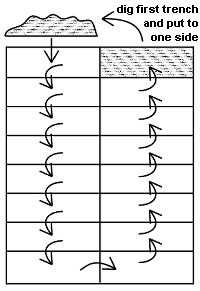Double digging
Double digging is recommended on a new vegetable or flower bed and, on heavy soils, every three or four years thereafter. It can be hard work if you are not used to it, but you can introduce yourself to it gradually, there's no need to complete a bed in one session, half an hour a day will get the bed dug in a reasonable time without putting your back out.
The best time of year to double dig a new vegetable or flower bed on clay soils is in the Autumn (October/November) - or Winter (through to February) during a frost-free and relatively dry period, this will allow the winter frosts to help break down the soil ready for Spring planting.
On light, free-draining soil, Spring is prepared as the time to dig to avoid the Winter rains from washing out the nutrients.
When digging a vegetable or flower plot for the first time, you will never be sure whether the soil is natural or if it have been levelled or filled in with builder rubble, so the first time it is dug may well produce a large pile of stones, house bricks and goodness knows what - this may cause the soil level to drop and addition top soil may need to be added from elsewhere.
On thin topsoil over clay, you don't want to bring quantities of clay to the top. There are advantages in removing the clay topsoil from the site and bringing in good quality topsoil, however this will produce a wet area and good land drainage will need to be provided to ensure that water can drain from the lower depths.
 On a square bed, the easiest
'plan of attack' is as follows (see diagram to the right):
On a square bed, the easiest
'plan of attack' is as follows (see diagram to the right):
- Start by digging a trench about 60cm (2 foot) wide and one spit (spade depth) deep of topsoil half way across the bed, place this soil onto the ground outside of the bed - placing it on a sheet of plastic or a board will protect the ground.
- Use a fork to fork over the subsoil to the depth of the fork prongs.
- If turf was removed from the bed, put some onto the subsoil (grass side down) and break it up with the spade. If no turf was removed, add some other organic material - well rotted manure, garden compost or similar.
- Stepping backwards, dig another 60cm (2 foot) trench of topsoil and put this onto the top of the subsoil/turf in the first trench, break up the topsoil and remove any large stones, roots of weeds etc.
- Repeat breaking up the subsoil in the new trench, putting in the turf or other organic material, covering with topsoil from the next trench, removing large stones and weeds etc until you reach the end of the bed.
- Now moving to the other side of the bed, dig out a similar 60cm (2 foot) trench of topsoil and put it in the last trench on the first side.
- Repeat digging as described the second side of the bed - forking the subsoil, putting in the turf/organic material, and covering with topsoil from the next trench - removing any large stones, roots of weeds etc as you go.
- When you reach the large trench, fill it in using the topsoil retained from the very first trench.
- Level off the whole bed using a rack.
This basic plan can be adapted to suit most shapes of vegetable/flower beds, just remember the process :-
- Remove a spit of top soil,
- Fork over the subsoil,
- Put in some organic material,
- Cover with topsoil and break-up, removing large stones and weeds,
- Level off.
All perennial weeds removed during the digging should be burnt. Any ash from burning the vegetation can be returned to the soil.
